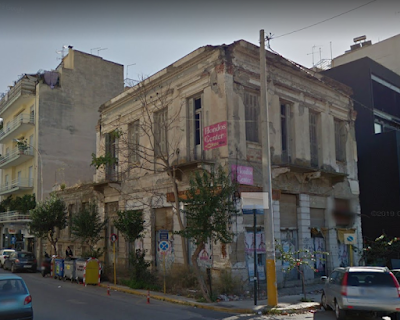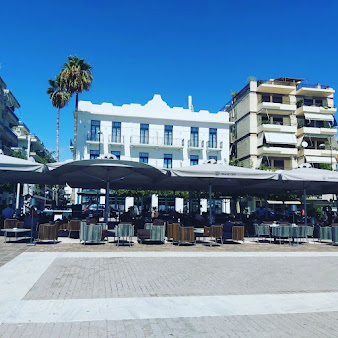'How did we eat calamari in the States?'
It was the question du jour among three American expats sipping coffee on a recent Saturday morning at the local beach cafe.
 |
| Pantazi Beach Cafe |
Our recollections were similar: calamari were breaded, deep-fried 'O-shaped' rings and miniature octopus-like pieces served on a plate with a hearty, but probably not healthy, side of dipping sauce.
 |
| Village fish taverna closing for the season |
The three of us had each just returned within a few weeks of each other from trips back to the United States. We were sharing tales of sticker- and culture-shock moments from our visits back as well as the joys of returning to this rural area of the Greek Peloponnese where we've chosen to make our homes.
One of the joys was dining on Greek food again and that sparked my comment about calamari. I'd recently posted on FB a series of photos taken on our last visit of the year to one of our local fish tavernas. It will reopen in the spring as many such eateries do in our area. My post included a photo of our entre, beautiful stuffed calamari.
 |
| Grilled stuffed calamari/squid |
Now for you seafood aficionados, this isn't a discussion of whether this is stuffed squid or stuff calamari; restaurants often use those words interchangeably here and it doesn't matter. When cooked correctly, as this was - stuffed with large shrimp, cheeses, veggies and herbs and so tender you could cut it with a fork it is simply ambrosia on a plate, by whatever name you choose.
Our mouths water when looking at the photo but that apparently wasn't the case with a few friends back in the States whose FB comments included: 'Ugh😂', 'Nope', 'Oh my. . .you have to be very brave'.
Another wrote, 'I wish I could get past the presentation' which made me think of the grilled calamari we had served to us on the island of Kalymnos this summer. The presentation on that one, pictured below, I will admit, gave me pause:
 |
| Grilled calamari - Kalymnos Island |
But another U.S. friend's comment is what provoked some real food for thought: 'Amazing cuisine. Yay to you Jackie!" So, I'm always so grateful you give us a window on how others live. Perspective is a very good thing!'
 |
| Grilled calamari - Kos Island |
Now that made me realize that my posts about life in Greece aren't so much about how
others live any more, but how
we live in this new adopted world of ours. Since becoming expats our perspectives have changed about many things, including food.
 |
| A 3-euro Greek breakfast 'toast' |
While I can't recall with certainty, I probably wasn't thrilled with the first couple of stuffed calamari I was served here.It wasn't what I was used to but my perceptions have changed as I've adapted to a new lifestyle. I laugh at the number of times during those early day breakfasts out in Greece when an order for 'toast and coffee' would result in a toasted ham and cheese sandwich without condiments - often with a mound of potato chips at the side -- being served in place of the plain bread, butter and jam we'd been expecting.
I'd be so disappointed. But I tell you, over the years, we've grown so found of Greek style 'toast' that we missed it while back in the States. It was one of the first things we ordered upon our return.
Truth be told, we expats admitted that despite having a good time back in the States, we missed many things about Greece while there.
STICKER AND CULTURE SHOCK
 |
| Travel between two worlds |
A number of folks have asked us about sticker- and culture-shock while back in our homeland. I might add a number of friends and family in the States had tried to prepare us for the costs we were going to encounter, but nothing really had prepared us for the reality of the increased prices there.
As we sipped our cappuccinos, we told of our experiences: One expat couple had shared a bagel and lox with two cups of coffee for a price of $50US in New York City. On our first day back, we visited what had once been our neighborhood Starbucks in a Seattle suburb. I purchased a pound of ground coffee, two double tall lattes, and a medium lemonade for $29. Another expat took two granddaughters to a favorite pancake breakfast hangout and ending up with a $70US bill.
 |
| Glass/bottle prices in US dollars at this winery |
The small central Washington State community in the heart of its wine country where The Scout and I have planted our US roots is a seasonal tourist destination. With some 19 wineries drawing visitors from far and wide, we expect prices there to be higher than what we pay for wine in Greece. But that still didn't ease the sticker shock of prices; an example of which is shown in the photo above.
 |
| Miso kilo/half liter of rose 3-euros |
Our first night back home in Greece we headed to our neighborhood taverna. This miso kilo, or half liter, of rose wine pictured above was 3-euros; the cost of our meal with the wine about same as the price of a bottle of Merlot at the winery shown above. (And the rose was very good.)
Now in fairness, sticker shock can also work in reverse and one of the best sticker shocks we had was the price of gasoline. While Americans are continuing to lament their gasoline prices, we rejoiced at paying between $4 and $5 a gallon. In Greece having hit just over $10 a gallon this summer, the price finally had dropped to $8 by the time we left for the States.
The topic of gasoline in the States, however, leads to one of my most illustrative examples of 'culture shock'. Not so much shock as perhaps, culture re-entry. It happened when I pulled into a service station to fill up the car. I realized I had forgotten how to pump gasoline. I used to do it routinely. But motorists don't pump gas in Greece. Stations are staffed and service provided. We pull up to a pump, tell the attendant, 'Yamato. . .95,' which means fill it up with 95 grade gasoline.
 |
| Our Toyota in the US |
I was doubled over laughing at myself by the time I pulled away from the pump. Now the 'big box' service station was bumper-to-bumper that morning and others at the pumps seemed to be entertaining themselves by watching my bumbling attempts. My first misstep was in hitting the wrong button at the side of the driver's seat. Instead of the small gasoline door opening at the side of the car, the entire front hood over the engine popped open. I had to raise the hood a bit, gaze at the engine and the close it so it might appear that I had opened it on purpose instead of out of stupidity.
I felt as if I had landed from Mars when I moved to the gasoline pump. Nothing was familiar! So many choices of types of gas and figuring out how to choose one of them seemed a sizeable task. To make matters worse, I had to tap my credit card on the appropriate screen on the pump before I could pump the gas and no amount of tapping would make it work. Finally, the one roving attendant took note of my plight and showed me how to select the grade as well as pointed out that tapping my card on the card reader worked better than tapping it on the instruction sign that said, 'then tap your card'.
 |
| It's a big world just waiting to be explored |
The reality is that the American prices may be up, but America's culture and ways of doing things haven't changed. It is those of us returning back to it for short bits of time who have changed. We do live differently from that which was once our rote way of living. And we see things from a completely different perspective than we once did.
We left Greece when summer nights were warm enough to warrant use of fans and/or air conditioning. We've returned to the cool nights of autumn that lend themselves to open bedroom windows and falling asleep to the sounds of the crickets and night critters.
This week the Hunter's Moon, the first full moon of autumn, is lighting the night sky. Autumn at The Stone House on the Hill means olive harvest and time to start traveling on this side of 'the pond'. We'll tell you about plans for both in future weeks! Until then safe travels to you and yours ~ and thanks for your time today!





































